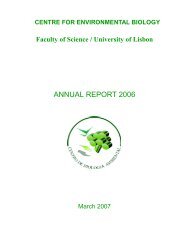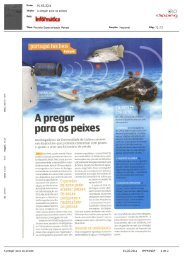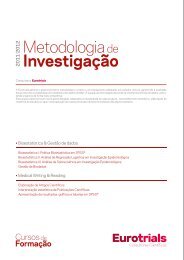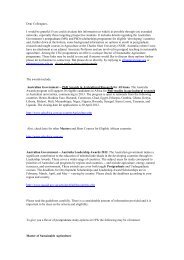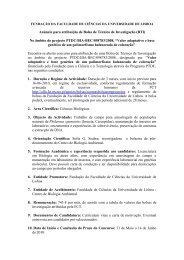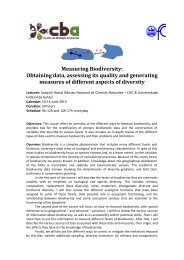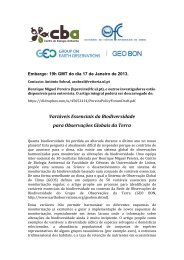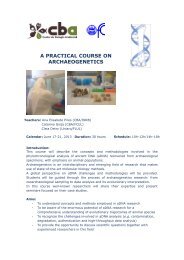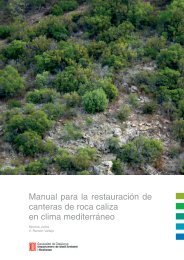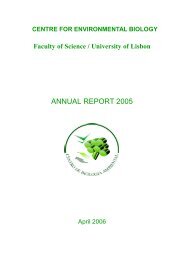European Red List of Vascular Plants - European Commission
European Red List of Vascular Plants - European Commission
European Red List of Vascular Plants - European Commission
Create successful ePaper yourself
Turn your PDF publications into a flip-book with our unique Google optimized e-Paper software.
plant species are classed as Extinct in the Wild: the<br />
grasses Bromus bromoideus and Bromus interruptus, and<br />
Lysimachia minoricensis. One CWR species, Allium<br />
jubatum, is Regionally Extinct within Europe and the<br />
EU. Furthermore, one aquatic species is Extinct at the<br />
<strong>European</strong> and global level, the Serbian endemic Trapa<br />
annosa; however it is not certain that T. annosa is a valid<br />
species. Two aquatic plant species and 19 CWR that are<br />
<strong>of</strong> marginal occurrence in Europe were considered in this<br />
assessment, but were classed as Not Applicable.<br />
The relatively high percentage <strong>of</strong> species assessed as Data<br />
Deficient (CWR: 29%, policy species: 20.3%, aquatic<br />
plants: 16%) is attributable to three main factors: a)<br />
insufficient knowledge <strong>of</strong> the species to apply the <strong>Red</strong><br />
<strong>List</strong> criteria, b) difficulties in accessing data for some<br />
countries, and c) taxonomic issues. In many cases,<br />
knowledge <strong>of</strong> the species’ distribution was available, but<br />
there was little, if any information about the population<br />
size, structure or trend. General knowledge about the<br />
habitats <strong>of</strong> the species, where known, could <strong>of</strong>ten be<br />
used to make inferences about threats to the species, but<br />
this is not enough to make a reasoned judgement about<br />
its threat status. The Data Deficient Category had to<br />
be applied to a number <strong>of</strong> species that showed declines<br />
in several countries, had been listed as threatened on<br />
national red lists, and had no evidence <strong>of</strong> a stronghold<br />
or centre <strong>of</strong> abundance anywhere. In those cases it would<br />
have been necessary to calculate an overall rate <strong>of</strong> decline<br />
within the last three generations or ten years – this<br />
type <strong>of</strong> information was simply not available and more<br />
research is needed to define the regional extinction risk<br />
<strong>of</strong> these species. Moreover, knowledge in the plant expert<br />
community in Europe extends mainly to populations<br />
within one single country and there are few botanists<br />
familiar with a species throughout its whole range. This<br />
causes two problems: firstly, data need to be collected<br />
from every national red list or other national sources and<br />
experts for each individual country need to be contacted<br />
which is complex and very time consuming. Secondly,<br />
different countries store data in different ways and<br />
national red lists do not necessarily provide more data<br />
than just the threat category and do not always follow the<br />
IUCN <strong>Red</strong> <strong>List</strong> Categories and Criteria. Data collected<br />
from each country was <strong>of</strong>ten so diverse that it was difficult<br />
to combine it in one assessment. Moreover, when experts<br />
where contacted via email or in a workshop, it proved<br />
difficult to review widespread species as most experts only<br />
wanted to provide a judgement at national level but were<br />
hesitant to do so for the <strong>European</strong> range <strong>of</strong> a species. It<br />
is clear that more work needs to be done to improve our<br />
knowledge <strong>of</strong> the threatened and conservation status <strong>of</strong><br />
Mandragora <strong>of</strong>ficinarum, is Regionally Extinct in the EU 27 but hosts small populations<br />
in Croatia and Bosnia and Herzegovina and is therefore assessed as Endangered in<br />
Europe. It has been used in traditional medicine and is a mythical plant that was<br />
associated with witchcraft and magic. Photograph © Michaela Wernisch.<br />
these species and that the network <strong>of</strong> <strong>European</strong> botanists<br />
needs to be strengthened.<br />
Looking at the population trends, 38.4% <strong>of</strong> the policy<br />
species, 16.0% <strong>of</strong> the <strong>European</strong> aquatic plants and at<br />
least 10.9% <strong>of</strong> the CWR species assessed are in decline.<br />
Stable populations have been reported for 21.8% <strong>of</strong> the<br />
policy species, 38.7% <strong>of</strong> the CWR species, and nearly<br />
two thirds (64.3%) <strong>of</strong> the aquatic plants. The percentage<br />
<strong>of</strong> species that have expanding populations is very low in<br />
each <strong>of</strong> the groups. The percentage <strong>of</strong> populations with<br />
an unknown population trend is notable: no population<br />
trend could be determined for nearly half <strong>of</strong> the CWR<br />
species (48.2%), compared to more than one third <strong>of</strong> the<br />
policy species (36.7%) and nearly one fifth (18.6%) <strong>of</strong> the<br />
aquatic plants. However, policy species are more likely to<br />
be monitored and therefore more population data were<br />
available. The population trend analysis in this report was<br />
based in many cases on survey data from only a small part<br />
<strong>of</strong> the species range or on subjective assessments based on<br />
known threats or habitat decline. It must be recognised<br />
that in many cases, particularly with wetland-dependent<br />
taxa, population counts are meaningless, either because<br />
plants mainly undergo vegetative and therefore clonal<br />
reproductions, are annuals (and therefore capable <strong>of</strong><br />
achieving populations in excess <strong>of</strong> a thousand individuals<br />
in the space <strong>of</strong> one or two generations) or because much<br />
<strong>of</strong> their growth is subterranean and it is not possible to<br />
define a single individual. In such cases we are obliged<br />
to fall back on weak definitions <strong>of</strong> populations or a<br />
measure <strong>of</strong> presence at a site. Better monitoring <strong>of</strong> the<br />
plants assessed is urgently needed, especially for those<br />
with an unknown and declining trend and those classed<br />
as threatened, Near Threatened and Data Deficient.<br />
44



